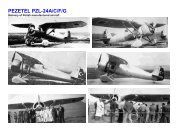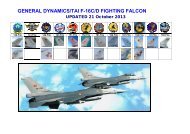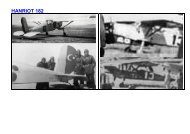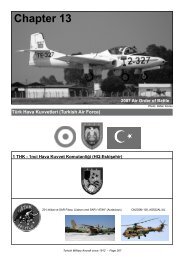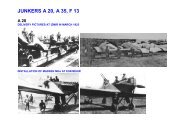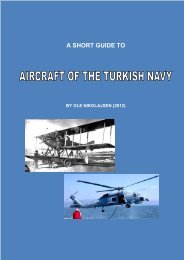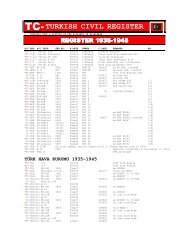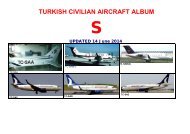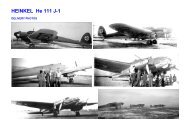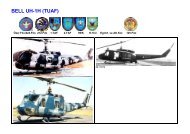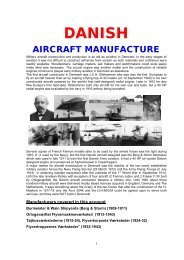OTTOMAN AVIATION 1909-1919 - Ole Nikolajsen
OTTOMAN AVIATION 1909-1919 - Ole Nikolajsen
OTTOMAN AVIATION 1909-1919 - Ole Nikolajsen
- No tags were found...
You also want an ePaper? Increase the reach of your titles
YUMPU automatically turns print PDFs into web optimized ePapers that Google loves.
<strong>OTTOMAN</strong> <strong>AVIATION</strong> <strong>1909</strong>-<strong>1919</strong><br />
FOREWORD<br />
<strong>OTTOMAN</strong> <strong>AVIATION</strong> <strong>1909</strong>-<strong>1919</strong><br />
The original Ottoman Aviation <strong>1909</strong>-<strong>1919</strong> was first researched in the 1980ties and now<br />
25 years later much new material has surfaced especially with regards to illustrations.<br />
As 2012 celebrates the first flight of a Turkish owned aircraft it seems appropriate to<br />
make a Version 2 of the original book in that year.<br />
In the first Version Bulent Yilmazer contributed much material for the first 3 Chapters,<br />
but has since made his own publications, however his original contributions are<br />
preserved also in the revised version. The rest of the book has been collected and rearranged<br />
by <strong>Ole</strong> <strong>Nikolajsen</strong> in this revised Version 2.<br />
25 years ago little was known outside Turkey about the role aviation had played in the<br />
formation of the modern national state. The original book and this revised version is<br />
attempting to rectify the lack of information outside and to some degree inside<br />
Turkey. The material researched for this book, is not an official presentation solely<br />
from official Turkish archives, but has also drawn on foreign material found by the<br />
author and cross referenced with other papers.<br />
Aviation came early to Turkey or the Ottoman Empire as it then was known<br />
before <strong>1919</strong>. In the 14th century, interest was already shown in the flight<br />
of man and later in <strong>1909</strong> when conditions became fertile for modernisation,<br />
flying in its modern form - powered aircraft and balloons - was introduced<br />
in Turkey. From then onwards aviation has progressed both in war and peace.<br />
Many Turkish air crews fell for their country but also in peace, great<br />
feats were performed. Feats never easily achieved. Contrary to what is<br />
generally known, large aviation forces were established and dispersed to<br />
all fronts of the Ottoman Empire in the 1st World War. With great sacrifice<br />
Turkish and German air crews fulfilled their assignments in their fragile<br />
aircraft in the deserts of Arabia and Iraq, over the towering mountains of<br />
Caucasus and in the stormy waters of the Black sea.<br />
The accounts of the 1st World War battles will give the reader a general<br />
political and military introduction, followed by a highly detailed insight<br />
into aircraft operations - from the Turkish point of view. Many accounts<br />
have been published about these events but this book will give a unique<br />
insiders view into operations from the losers side. Moreover, a more<br />
balanced impression of many famous 1st World War battles - Gallipoli,<br />
Kut-al-Amara, Sinai, Palestine - can be derived from the information.<br />
On October the 30th 1918, Turkey achieved armistice but not peace. Soon<br />
strong outside powers were interfering with the apparent aim of ripping<br />
apart the former empire and then the Turkish motherland. These plots by the<br />
victors of the war never succeeded due to the determined resistance of the<br />
Turkish people under its visionary leader Mustafa Kemal Paşa-Atatürk.<br />
This book is a documentary on aviation. War is only included because war<br />
existed almost continuously from 1911 to <strong>1919</strong> for the Turkish people.<br />
With the start of <strong>1919</strong> aviation in Turkey became TURKISH aviation and the<br />
book is therefore appropriately called <strong>OTTOMAN</strong> <strong>AVIATION</strong> <strong>1909</strong>-<strong>1919</strong>.<br />
1
<strong>OTTOMAN</strong> <strong>AVIATION</strong> <strong>1909</strong>-<strong>1919</strong><br />
FOREWORD<br />
<strong>OTTOMAN</strong> <strong>AVIATION</strong> <strong>1909</strong>-<strong>1919</strong><br />
PAGE<br />
FOREWORD 1<br />
DEDICATION 2<br />
LIST OF CONTENTS 3-4<br />
LETTERS, NAMES, LOCATIONS, DATES AND RANKS 5-7<br />
NATIONAL MARKINGS 8<br />
INTRODUCTION 9-10<br />
CHAPTER. 1 11-18<br />
A NEW FORCE OF SIPAHI-THE START OF <strong>OTTOMAN</strong> ARMY <strong>AVIATION</strong><br />
1912<br />
CHAPTER. 2 19-28<br />
THREE WARS IN ONE YEAR THE BALKAN WARS<br />
OCT.1912 - SEP.1913<br />
CHAPTER. 3 29-40<br />
EXPLORATION OF THE EMPIRE<br />
OCTOBER 1913 - AUGUST 1914<br />
CHAPTER. 4 41-48<br />
A TOTALLY INADEQUATE FORCE<br />
- THE FIRST MONTHS OF WAR FOR THE <strong>OTTOMAN</strong> FLYING UNITS<br />
1914<br />
CHAPTER. 5 49-56<br />
THE REVIVAL OF THE <strong>OTTOMAN</strong> ARMY FLYING ORGANISATION<br />
1915<br />
CHAPTER. 6 57-76<br />
AIRWAR OVER GALLIPOLI<br />
1915-1916<br />
CHAPTER. 7 77-100<br />
A MULTIFRONT AIRWAR<br />
1915-1918<br />
CHAPTER. 8 101-124<br />
PASA AND YILDIRIM - THE PALESTINE FRONT<br />
1915-1918<br />
CHAPTER. 9 125-156<br />
THE BATTLES OF THE RIVERS - THE IRAQ FRONT<br />
1915-1918<br />
CHAPTER. 10 157-174<br />
MOUNTAIN WARFARE (THE BATTLE FOR CAUCASUS)<br />
1915-1918<br />
2
<strong>OTTOMAN</strong> <strong>AVIATION</strong> <strong>1909</strong>-<strong>1919</strong><br />
FOREWORD<br />
CHAPTER. 11 175-184<br />
THE AIR DEFENCE OF ISTANBUL<br />
1917-1918<br />
CHAPTER. 12 185-216<br />
THE COASTGUARD OPERATIONS IN WEST ANATOLIA AND THE BLACK SEA<br />
1916-1918<br />
CHAPTER. 13 217-224<br />
PEACE WITHOUT PEACE<br />
1918<br />
CHAPTER. 14 225-250<br />
AIRCRAFT DELIVERED<br />
1912-1918<br />
CHAPTER. 15 251-262<br />
AIRCREW SERVING WITH THE <strong>OTTOMAN</strong> FORCES<br />
OR GERMAN FORCES IN THE <strong>OTTOMAN</strong> EMPIRE<br />
1914-1918<br />
SOURCES AND REFERENCES 263<br />
FRONT PAGE Yeşilköy Apr.26 1912. The Minister of War, Army commanders and "Tayyare Komisyony<br />
-Aircraft Committee" members have just witnessed the first Ottoman military flight.<br />
Gnkur.<br />
Abbreviation for Genel Kurmay<br />
Kolordu<br />
corps, as a military unit<br />
Kurmay<br />
staff officer<br />
Ordu<br />
army<br />
3
<strong>OTTOMAN</strong> <strong>AVIATION</strong> <strong>1909</strong>-<strong>1919</strong><br />
FOREWORD<br />
Piyade<br />
Infantry<br />
Ottoman Aviation Pilot`s Brevets<br />
NATIONAL MARKINGS OF <strong>OTTOMAN</strong> ARMY/NAVY AIRCRAFT<br />
MARCH 1913 - OCTOBER 1918<br />
ARMY ONLY<br />
MARCH 6, 1913<br />
TO<br />
MARCH 1915<br />
WINGS FUSELAGE TAIL FIN<br />
ÎŨώ ζί˘ί б<br />
Name in<br />
arabic<br />
letters<br />
MARCH 1915<br />
TO<br />
APRIL 1916<br />
NAVY ONLY<br />
1914<br />
TO<br />
APRIL 1916<br />
Arabic<br />
numbers<br />
ARABIC NUMERAL CALIGRAPHY:<br />
ARMY & NAVY<br />
APRIL 1916<br />
TO<br />
MID-1917<br />
G 961<br />
Arabic<br />
numbers<br />
Army<br />
Navy<br />
MID-1917<br />
TO<br />
OCT. 1918<br />
AK 6<br />
4
<strong>OTTOMAN</strong> <strong>AVIATION</strong> <strong>1909</strong>-<strong>1919</strong><br />
FOREWORD<br />
INTRODUCTION<br />
As in other parts of the world, the concept of manned flights fascinated the<br />
people of the varied and cosmopolitan Ottoman Empire. Science and arts played a<br />
significant role in the Empire and it was primarily the scholars of these<br />
interests who also looked upon the flight of man.<br />
The first projects and attempts were approached in two ways; by rocket power or<br />
winged flight.<br />
In the 14th century, a thesis, detailing the manufacture and theory of rocket<br />
flying was written by a group of military rocket artillery commanders -Alaaddin<br />
Tayboğa, Al Omari, As Saki and Al Meliki.<br />
In the middle of the 15th century Sultan Mehmet "Fatih" ordered courses in rocket<br />
technique to be held for Ottoman officers.<br />
Later, in the 16th century, the Turkish art of Pyrotechnics was refined for both<br />
military and civil uses. A book explaining the atmosphere of the earth, wind<br />
systems and general meteorology was published. In the same period great interest<br />
was shown in the ability to soar as the birds. It soon became fashionable in<br />
Istanbul to fly large and elaborate kites. In the middle of the 17th century,<br />
Hezarfen Ahmed Çelebi started to build wings but instead of imitating the<br />
flapping of bird wings, he used them for gliding. During 5O years of tireless<br />
work, this scientist worked to perfect his wings and numerous tests were made. He<br />
even attempted to launch himself from the Galata tower in İstanbul to cross the<br />
Bosporus. The fact that Çelebi was not killed in the attempt shows that the wings<br />
were functional. Eventually a set of wings measuring 9×1,5 meters were found most<br />
useful. As with modern hang gliders they carried no tail or steering surfaces,<br />
control was obtained by weight shifting. Flights of up to 5 minutes duration were<br />
performed. The 18th century also saw a keen interest in rockets and several<br />
successful military models were employed. Many large publications were issued on<br />
rocket aerodynamics and propulsion. The year 1782 saw the first balloon ascent in<br />
the world in France and as early as 1785 an Iranian balloonist made an ascent in<br />
İstanbul.<br />
In September 1802 two British balloonists<br />
Barley and De Vigne also made an ascent in<br />
İstanbul. The first Turkish balloon to fly<br />
was a hot air type, constructed and flown by<br />
Selim Ogat in İzmir in 1825. The period up to<br />
1900 saw numerous foreign balloonists arrive<br />
in İstanbul to demonstrate their equipment<br />
with various degrees of success. One<br />
particular ascent was made on the 12th of<br />
June 1845 by the Italian Comaschi who tried<br />
to sell his models to the Ottoman Army.<br />
Although most other countries in Europe at<br />
this time were employing military balloons,<br />
the Ottoman Army was not interested. The<br />
balloonist M. Godard made a ascent in 1859.<br />
In 1861 Atıf Bey who lived in Bebek, north of<br />
İstanhul, constructed a glider. The first<br />
test flight was on the 26th of July when it<br />
succeeded in gliding 400 meters.<br />
Manned flight in the Ottoman Empire, however,<br />
did not make a real impact until <strong>1909</strong>. Then<br />
western oriented and open minded Turkish<br />
officers came into power. It was the wish of<br />
these men to modernise the large empire. On<br />
the 13th of April <strong>1909</strong>, Mahmud Şevket Paşa<br />
became Minister of War and this<br />
extraordinarily resourceful man started to<br />
modernize the Ottoman armed forces.<br />
Invitations were sent to France for aviators<br />
to demonstrate their equipment in İstanbul.<br />
First to respond was the French balloonist<br />
The French balloonist Barbout and Turat<br />
ascents in their Astra balloon<br />
Barbout who, with his assistant Turat,<br />
arrived in İstanbul in May <strong>1909</strong>. They<br />
performed the first balloon ascent for 40<br />
years in the city on the 28th of May in their<br />
Astra (1545, Paris). The balloon sporting the Turkish and French flags was<br />
watched by thousands of people including the adjutant of the commander of the 1st<br />
5
<strong>OTTOMAN</strong> <strong>AVIATION</strong> <strong>1909</strong>-<strong>1919</strong><br />
FOREWORD<br />
Ottoman Army. Three more ascents were made in İstanbul carrying many Government<br />
officials.<br />
In November, the Belgian pilot Baron de Catters arrived with his yellow painted<br />
Voisin aircraft. The Baron made his first flight on the 2nd of December climbing<br />
to 20 meters on a 200 meter long flight. This was the first powered<br />
heavier-than-air manned flight in Turkey. A second flight was made on the 5th,<br />
watched by the Minister of War and several other high ranking officials. This<br />
flight lasted more than one hour and took the aircraft as far as Kasımpaşa before<br />
a landing was made. De Catters then left for Egypt to demonstrate his aircraft<br />
there.<br />
Some days after De Catters had left, the famed aviator Bleriot arrived in<br />
İstanbul to demonstrate his aircraft. On the 11th of December, more than 10.000<br />
spectators gathered near Taksim north of İstanbul to watch Bleriot's flight. But,<br />
at a height of 40 meters, the aircraft was suddenly caught by a gust of wind. It<br />
hit a house and two trees and crashed into a garden. Slightly injured Bleriot was<br />
brought to the French hospital in the city where he quickly recovered.<br />
These flights in <strong>1909</strong> made a great impression upon the new young leaders and the<br />
general public and soon a decision was taken to buy aircraft for Turkey.<br />
A balloon ascent at Istanbul in 1845 being celebrated with a huge party<br />
On Dec. 11th <strong>1909</strong> Bleriot made a flight in İstanbul. To the right the crashed aircraft.<br />
6
<strong>OTTOMAN</strong> <strong>AVIATION</strong> <strong>1909</strong>-<strong>1919</strong><br />
FOREWORD<br />
HOW TO ORDER:<br />
Price: 20 Euros/25$ incl. postage<br />
If you already have the 1 st Version of the CD:<br />
Price 10 Euros/12,50$<br />
If you bought the first CD within the last year: FREE<br />
Send the money via PayPal: ole.nikolajsen@orange.fr<br />
Or as cash in a registered letter to:<br />
<strong>Ole</strong> <strong>Nikolajsen</strong>, 1037 les Tuileries, 46000 Cahors,<br />
FRANCE<br />
For further information :<br />
<strong>Ole</strong>.nikolajsen@orange.fr<br />
7



